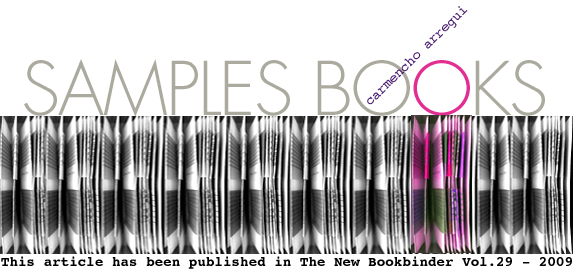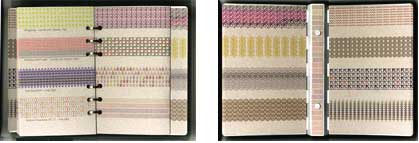
Some years ago while visiting Milan’s Antique Books Fair I saw two Japanese samples books of textiles. Unfortunately I could not afford to buy them but I sat on the floor (fairs are ever so crowded and uncomfortable) and looked at them from the first to the last page. The samples were not pieces of silk or embroidery but simple cotton for everyday kimonos. The covers of these two albums were modest and worn-out but absolutely coherent with their content.
Objects that look alike tend to increase their beauty when shown together. If you see ten different colour cups in a shop and you choose the one you like best you will discover that it does not look as good, once you have taken it home.
It is probably the interaction of colours and patterns that make samples books so attractive.
I have been making some for an exhibition that will take place in Sweden in 2010.

A Crossed Structure Binding Hidden is a suitable binding for a typographic samples book of computer printed papers (click image 1). To know more about this structure see ‘CSB Hidden’ in this website.
I wanted it to be in paper assembled with wire staples to avoid adhesive. Each side of the cover is made of a folded paper so that the closing of the staples remains in between the two layers and there is no danger of scraping or even touching the book block. Another interesting feature is the preparation of the inner pages made in Khadi paper. I have made two vertical cuts that are not aligned, to avoid the weakening of the page (click image 2). Each sample goes into the cut and winds around the front edge; both ends of the printed strips join at the back and are fixed to one another with a thin acid free double-sided adhesive tape. In this way the samples are not fixed to the pages of the book and can be replaced any time. The front edge is quite attractive with the coloured samples showing (click image 3). (The book measures 170x180x18mm).

A ready-made aluminium notebook has been transformed into a practical typographic samples book. I have chosen grey Fabriano paper for the inside and printed the pages with the computer (each with four different patterns), I have then folded the paper backwards and linked every page to the rings at the spine. Indications of the fonts used for the patterns are written under each sample so that they can be reproduced any time. Here again the different colours enhance the front edge. A printed paper partially hides the metal covers outside and in (click images 1 and 2). (The book measures 200x160x28mm).

Fifteen small bindings are the samples I carry with me for some of my workshops. I have made three small books out of ready-made CD containers with inner rings. To prevent the booklets from falling out when the samples book is carried around a hook has been added at the front edge (click image 1).
The inside pockets are made with a folded A4 Fabriano sheet of paper. The folding provides two pockets opposite to each other (click images 2 and 3). Each pocket carries a dromo of the book it contains. This is a very practical solution to make sure I have not forgotten any of them once the workshop is finished. (The book measures 150x160x28mm).

A Crossed Structure Binding Linked is the binding I have chosen for a book with samples of my bookbinding experiments that have been hanging around for years in my workshop (click image 1).
Each scrap has been visually linked to the image of the finished binding printed on the opposite page (click image 3).
The book-block is a sewn concertina that allows hiding the thread that fixes the items to the pages and is made in Zaansch bord Dutch Paper. The swell, being one of the problems of this particular book, was perfectly taken up by the independent sewing of each inner fold of the concertina. I have purposely left the binding unfinished so that the holes in the middle of the sewing supports that prevent the sewing from sliding up can be seen. In this case this samples book is in itself a technical sample (click image 2). (The book measures 190x140x27mm).
To know more about this structure see ‘CSB Linked’ in this website.

Born to be exhibited – I made this book for a collection of samples of my old roller printed papers. The binding has flexible double vellum covers fixed to inner spine flaps that allow a wide opening. The vellum at the spine has folds to protect the sewing thread and to provide mobility. Two pieces of vellum inserted between the sewing stations prevent the complete expansion of the folds and keep the spine in shape. The standing position of the book allows both the display of the spine and the disclosure of the decorated papers inside (click images). (The book measures 230x190x40mm).
You can find more explanations about this structure in section: ‘Spines 1’ and if you wish to know more about roller printed papers see: ‘Rolling Rollers’ in this website.
Acknowledgment: All my gratitude goes to Jen Lindsay who, for many years, has corrected my English in all my publications, including this website.
![]()
